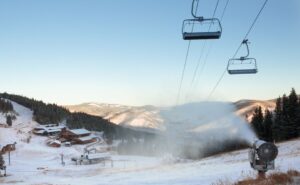Widgetized Section
Go to Admin » Appearance » Widgets » and move Gabfire Widget: Social into that MastheadOverlay zone
Vail starts snowmaking but remainder of October looks to be warm, dry
Editor’s note: Since this story was first posted on Oct. 15, the forecast has changed as a powerful winter storm is expected to deposit more than a foot of snow in the Colorado mountains Sunday and Monday, Oct. 25-26. It will hopefully extinguish the East Troublesome Fire in Grand County, which blew up to become the fourth largest in state history on Wednesday, Oct. 21.
A few Colorado ski areas, including Vail, have started making artificial snow for the coming 2020-21 season, but the near-term weather forecast for the rest of October isn’t all that promising for an abundance of early natural snow to kick off an uncertain ski campaign.

State officials have released guidance for the coming ski season as the industry hopes for good snow to offset the travel uncertainties of the COVID-19 pandemic. And wildland firefighters across Colorado are desperate for any kind of precipitation as unseasonably dry, warm weather has stoked record-breaking wildfires across the state.
The Cameron Peak Fire in the foothills west of Fort Collins surged by 20,000 acres on Wednesday, with winds exceeding 50 mph. It is now the largest fire in Colorado history, surpassing the Pine Gulch Fire near Grand Junction. Colorado has now seen the two largest fires in state history – both in the same summer/fall fire season.
Closer to home, the Grizzly Creek Fire that started in Glenwood Canyon and surged east into Eagle County earlier this summer is the largest ever in the surrounding White River National Forest. Meanwhile, severe drought conditions have persisted into the fall.
Unfortunately, the near-term forecast is not too promising either for firefighters or the ski industry.
“Wednesday’s wind gusts of 50+mph led to the extreme growth of the Cameron Peak Fire,” Colorado Open Snow reported on Thursday. “Thankfully, a cold front on Wednesday night slowed the wind speed, changed the wind direction, and is also helping higher elevation northern mountain resorts to make snow. The general outlook for the next 10 days, though, is for more wind, a few cool bursts, and little natural snowfall.”
Vail Mountain, according to is Facebook page, kicked off snowmaking operation on Monday. The resort is set to open for the season, with a reservations system, on Friday, Nov. 20.
Vail Resorts offered the following description of the reservation system on its Facebook page this week, with more details on the company web page:
“An Epic Pass will provide you 7 priority reservation days that you can begin using as soon as the system opens on Nov. 6. These priority reservation days can be used to lock in a major trip you’ve been planning or simply specific weekends you know you will want to ski and can be booked out as far out as you’d like. In addition, priority reservation days are rolling so if you were to reserve the weekend of opening day Nov 20-22, as soon as you ski that first day on Nov 20 you can use that priority reservation day for a day later on in the season. Week of reservation days are used for any other time you would like to ski this season outside of your priority reservation days. They can be used to book a ski day from as early as a week prior to as late as the morning of, availability permitting. Hope this helps!”
Here’s the state of Colorado press release from Wednesday on its ski-area guidance:
State seeks feedback on guidance for ski areas and resorts
REMOTE, (Oct. 14, 2020): The Colorado Department of Public Health and Environment (CDPHE) is seeking feedback on newly drafted ski guidance. Stakeholders and the public should submit feedback by Friday, Oct. 16 at 10 a.m. MT. The guidelines draw from existing and well-known COVID-19 guidelines for industries, establish some new baseline standards to create common expectations for mountain-specific activities, and support the local planning and implementation of area-specific plans critical to success. A robust work group of local government officials, Local Public Health Agencies, industry partners, and subject matter experts at the state helped develop this draft.
“Ski areas are a vital driver of the Colorado economy. During the COVID-19 pandemic, these areas also present unique challenges for controlling virus transmission. A successful ski season will require a strong partnership between ski areas, local governments, local businesses, and the state,” said Jill Hunsaker Ryan, executive director, CDPHE. “We can use what we’ve learned in the pandemic so far to mitigate risk in ski areas.”
These guidelines demonstrate that:
- Ski areas should work closely with their local public health agency (LPHA) to develop an area-specific plan and submit it to the LPHA and CDPHE for approval.
- Ski areas will need to ensure safe employee housing arrangements that mitigate the spread of COVID-19.
- Protocols for crowd management, mask and face-covering mandates, and physical distancing requirements need to be included in the area-specific plans.
- Each ski area must work with their local community to develop community-wide plans to ensure lodging guests can safely isolate and quarantine themselves in the event they test positive during their stay.
- Read the full draft guidance.


